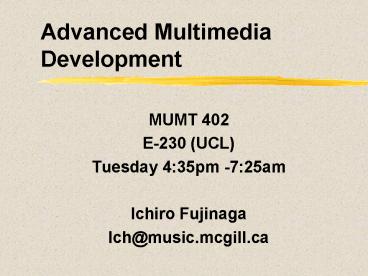Advanced Multimedia Development - PowerPoint PPT Presentation
Title:
Advanced Multimedia Development
Description:
Music Technology Computer Lab (E230) and ... in some way and then send out messages using the object's outlets ... must return a pointer to the new instance ... – PowerPoint PPT presentation
Number of Views:29
Avg rating:3.0/5.0
Title: Advanced Multimedia Development
1
Advanced Multimedia Development
- MUMT 402
- E-230 (UCL)
- Tuesday 435pm -725am
- Ichiro Fujinaga
- Ich_at_music.mcgill.ca
2
Introduction
- Overview of this class
- Review
- First object bang
3
Overview of class
- Design, programming, and deployment of music and
audio in multimedia production. Topics include
complex MIDI programming, audio synthesis
algorithms, interactive music. Most of
programming will be performed within the context
of Max/MSP environment by developing external
objects. - Mark Distribution
- 15 Mid-term exam
- 25 Final exam
- 10 Participation
- 50 Assignments
4
Assignments
- Weekly assignments
- Assignment policy
- All assignments are due at midnight of the due
date. - Late assignments within 48 hours past the
deadline will be given either D or F. - Assignments submitted after 48 hours past the
deadline will be given F. - Collaboration (www.mcgill.ca/integrity)
- Neatness, elegance
5
Contact
- Email ich_at_music.mcgill.ca
- Webpage www.music.mcgill.ca/ich
- Phone 398-4535x00944
- Office E233
- Office hours Fri. 2-4pm or by appointment
6
Music Technology Computer Lab (E230) and linux
accounts
- Get MTCL account from Richard McKenzie
(mckenzie_at_music.mcgill.ca) - Get linux (shell, ftp) account on music.mcgill.ca
- Create your web home page (assignment 1)
- Basic personal info
- Links to your classes
- Place to post your assignments
7
Review I
- What is
- Max
- MSP
- OOP
- Class
- Objects
- Messages
- Encapsulation
- Inheritance (not implemented in Max/MSP)
8
Review II
- What is
- Compiler
- Library
- Linker
- Shared library
- DLL
- Plugin
- External objects
9
Writing max External Objects
- Initialization
- main()
- Definition of methods to create new object
- Definition of methods to bind to other messages
10
The bang object Initialization
- include "ext.h // Required for all Max
external objectsvoid this_class // Required.
Global pointing to this class - Required for all objects
- ext.h in Max/MSP SDK
- contains other header files
- prototypes
- this_class is used as a pointer to this class
11
The bang object Initialization (data)
- typedef struct _bang // Data structure for this
object t_object b_ob // Must always be the
first field - // used by Max void b_out // Pointer
to an outlet t_bang - Must start with t_object (see ext_mess.h)
- Max convention first letter followed by
underscore - Every object has an inlet
- b_out is a pointer to an outlet
12
The bang object Initialization (methods)
- // Prototypes for methods
- // need a method for each incoming message
- void bang_new(void) // object creation
method void bang_bang(t_bang bang) // method
for bang message - Declaration of class methods that will respond
to Max messages - Objects respond to messages from the Max
environment - Objects receive messages (integer, float,
symbol) in their inlets - Objects methods will process these messages in
some way and then send out messages
using the objects outlets - This bang object responds to new an bang
messages
13
The bang object main()
- When an object is created for the first time
- External object is loaded into memory
- main() is executed once and only once
- main() specifies how the object should be
initialized - Setup the class
- Allocate memory for the object
- Specify method for the creation of instances of
the object - Define messages that the object can respond to
and bind each message to a method
14
The bang object main() cont.
- void main(void)
- // set up our class create a class definition
- setup(this_class, (method)bang_new, 0L,
(short)sizeof(t_bang), 0L, 0) - // bind method "bang_bang to the "bang" message
- addbang((method)bang_bang)
- Setup creates the class
- Get pointer to the class, specify instance
creation method, instance free method, size of
each instance, GUI object. - addbang binds the method to bang message
coming into the left inlet (addint, addinx,
addmess, addft, and addftx)
15
The bang object main() cont.
- void main(void)
- // set up our class create a class definition
- setup(this_class, (method)bang_new, 0L,
(short)sizeof(t_bang), 0L, 0) - // bind method "bang_bang to the "bang" message
- addbang((method)bang_bang)
- Setup creates the class
- Get pointer to the class, specify instance
creation method, instance free method, size of
each instance, GUI object. - addbang binds the method to bang message
coming into the left inlet (addint, addinx,
addmess, addft, and addftx)
16
The bang object The object creation function
- void bang_new(void)
- t_bang bang
- // create the new instance and return a pointer
to it - bang (t_bang )newobject(this_class)
- bang-gtb_out bangout(bang) // create a bang
outlet - return(bang)// must return a pointer to the new
instance - Creates an instance of the class by newobject()
- Outlet is created by bangout() and assigned in
the object s struct
17
The bang object Handling the bang message
- void bang_bang(t_bang bang)
- // send a bang to the outlet bang-gtb_out
- outlet_bang(bang-gtb_out)
- This method is called when bang message is
received at the left inlet, because of addbang(), - The bang_bang method simply sends a bang
messages via the outlet via a max method,
outlet_bang() - The outlet, bang-gtb_out was created by bangout()
18
Ichs C style
- no space before commas and semicolons
- no space after function names
- space after commas and semicolons
- space before and after an operator
- space after keywords
- vertically align matching braces (optional)
- no magic numbers































